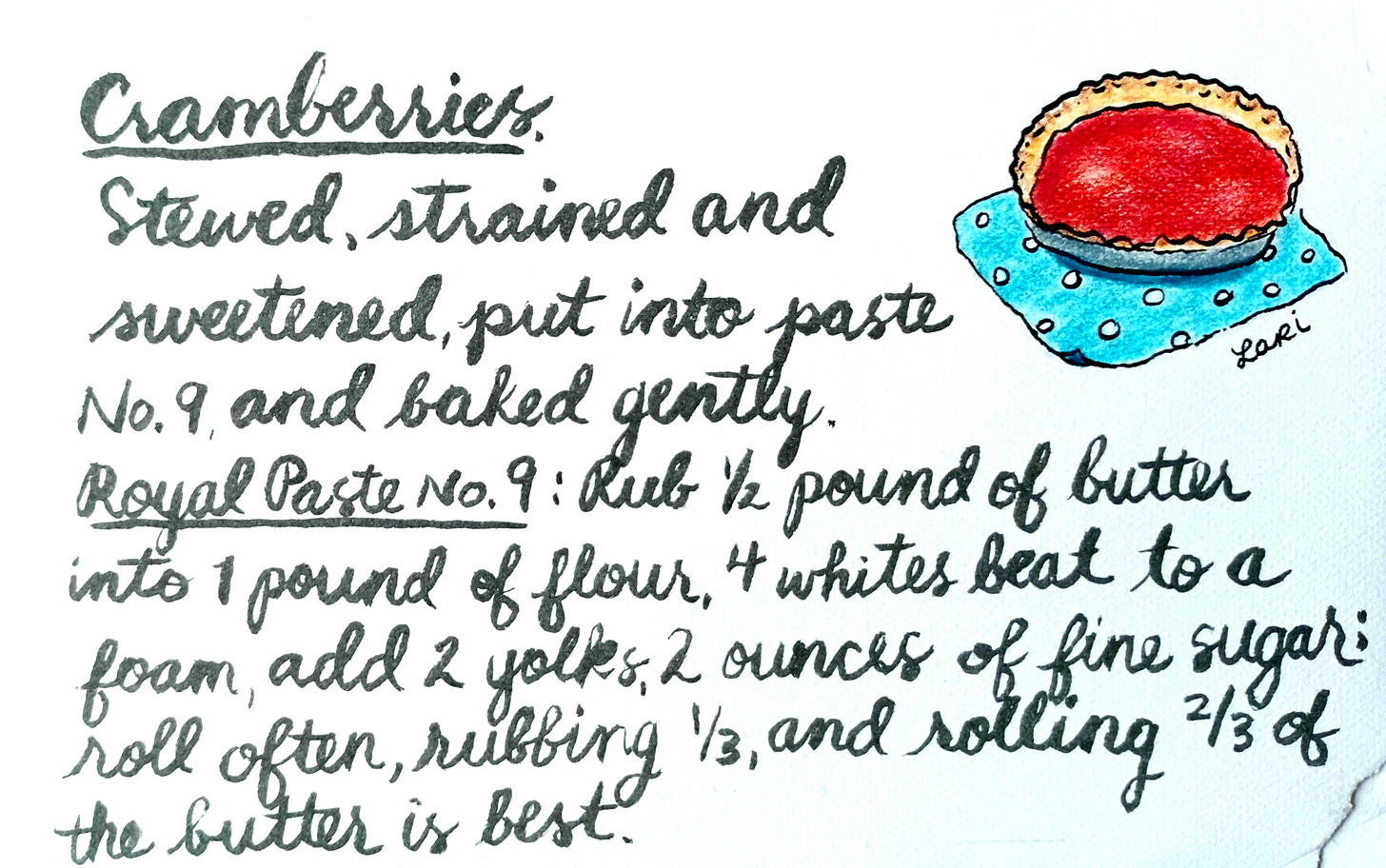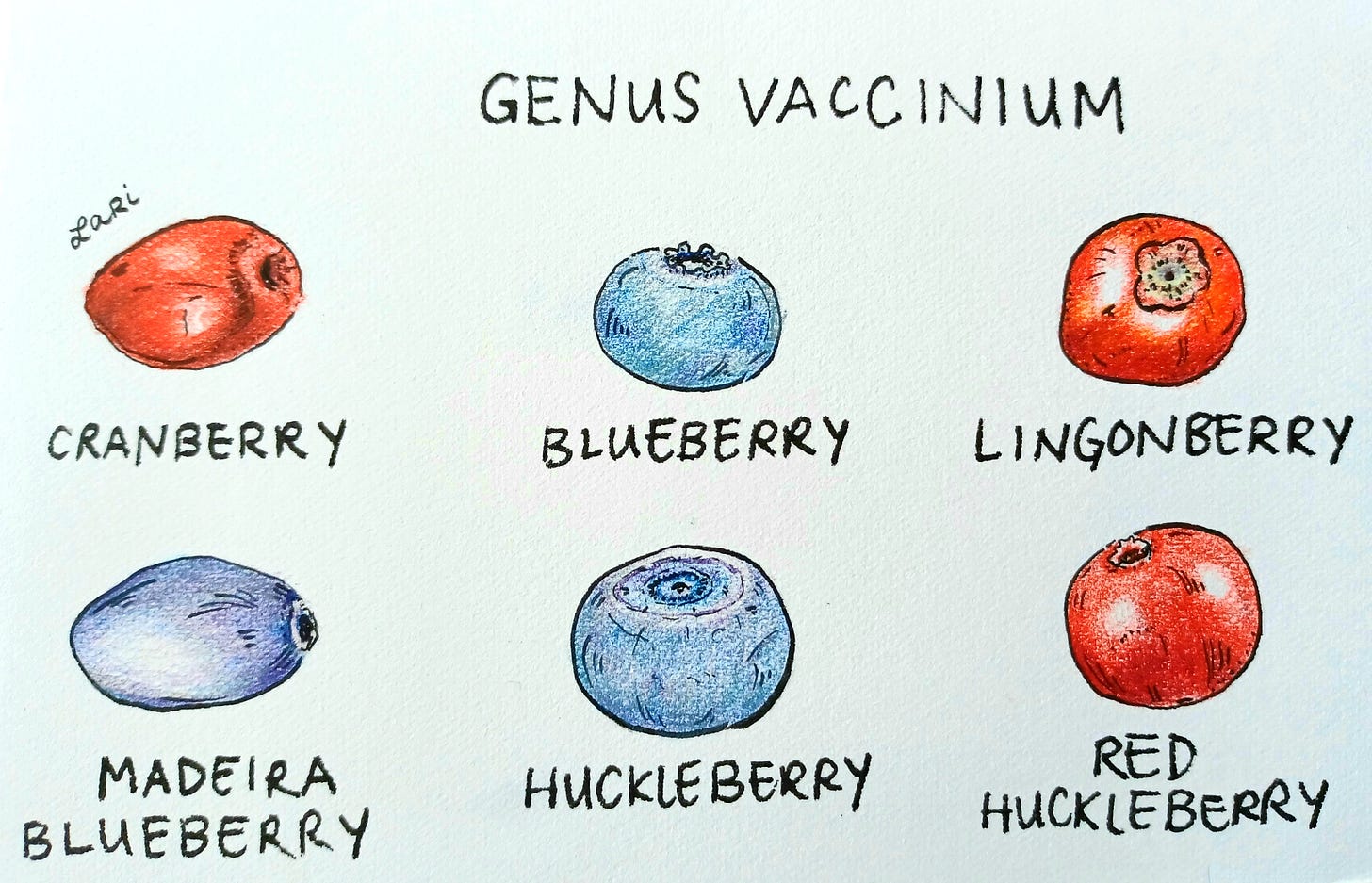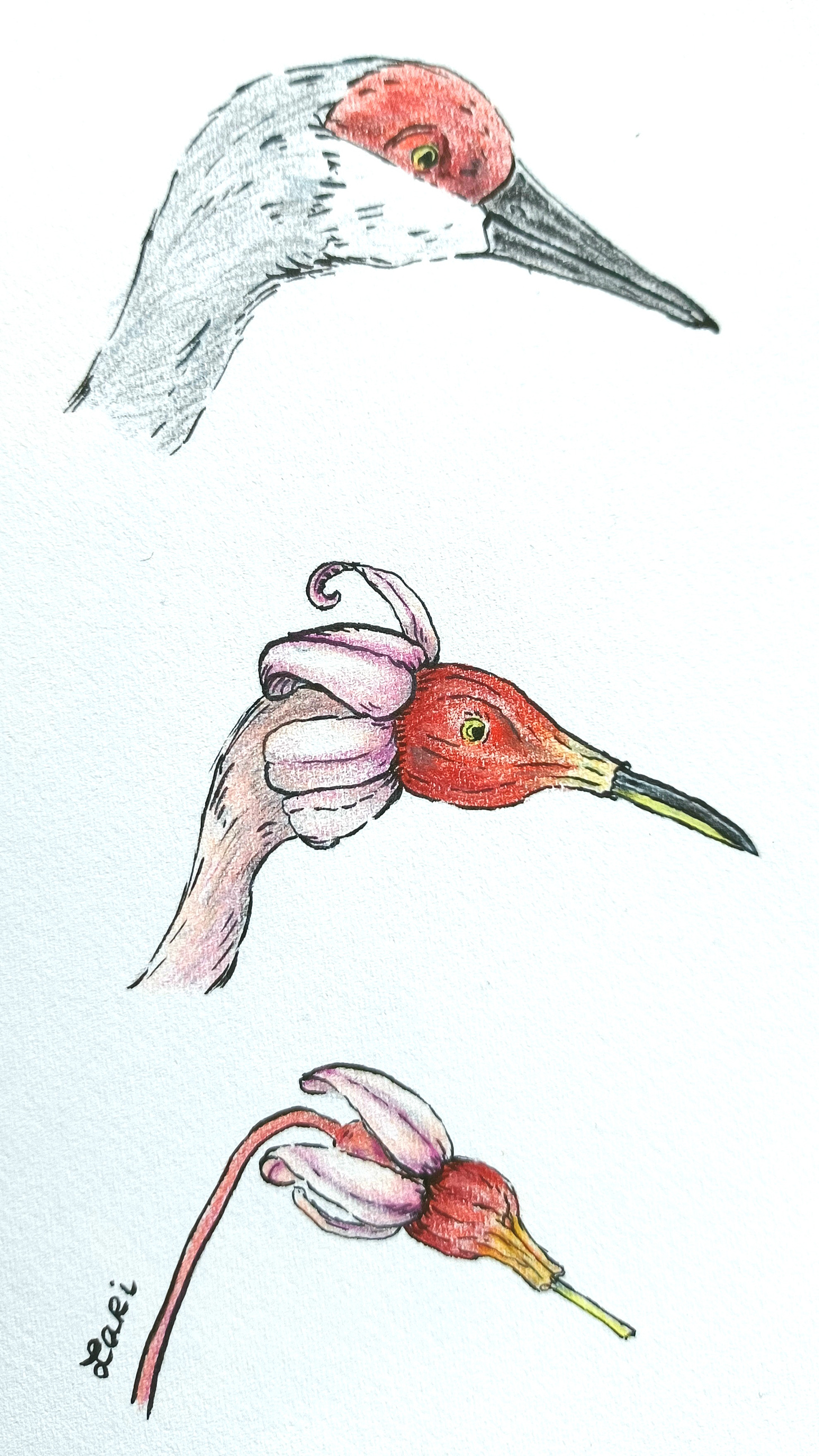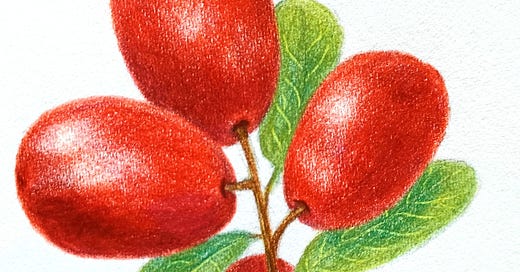Welcome back to RENDERED. As I wrote last month about pumpkins, food takes on the symbolic meanings that we assign to it. They may greatly diverge from those of different traditions from our own. One reason I write this newsletter is to examine each subject as if it were not a flat object, but rather a prism.
Whether it's cranberries, Thanksgiving or otherwise, the stories we tell deserve to be questioned. This year is the 400th anniversary of the first Pilgrim Thanksgiving. Ignoring sentimental musings, it's a prime moment to consider not only the myth of Thanksgiving, but of other stories we might be taking for granted.

Pemmican is one notable use of cranberries. "Pemmican" (from a Cree word meaning "grease") is a survival food--regional variations abound, but at its simplest, it is dried meat (bison, elk, deer, moose, or even fish) stirred into rendered fat. Cranberries were also mixed in, offering not only extra flavor, but nutrients and a bonus anti-microbial agent, benzoic acid. The fat hardens as it cools, forming a block of preserved meat, an indispensable foodstuff that could last for years. A preparation of Native origin, pemmican later became associated with the Métis culture, and demand began to soar. Pemmican production was thus ramped up and commercialized in the 18th/19th centuries, which fed voyageurs (fur traders), fronteirsmen, and the military.
Cranberries, in the form of sauce, famously give a tangy complement to the traditional Thanksgiving turkey. As a bright-eyed schoolchild, I grew up surrounded by construction-paper hand turkeys, images of golden roast turkey and cranberry sauce, and the story of the holiday: a blossoming friendship between the Pilgrims and the Wampanoag.
Of course, this is just a story.
The ship Mayflower left England full of Pilgrims intending to form the first English colony in Virginia. These Puritans were inspired by the Protestant Christian teachings of John Calvin: they believed they had divine right to show up and take over--through divine right and predestination, they carried the banner of righteousness and self-bestown authority. After erroneously landing in November 1620 in what is now Cape Cod, Massachusetts (nowhere near Virginia), some of the men onboard wrote the Mayflower Compact--essentially, it was a permission slip to stay where they landed, and establish authority in themselves, so as to quell mutinous dissention.
The Wampanoag, who trace their history in the region back at least 10,000 years, are the tribe the Pilgrims met. Previous interactions with Europeans had left Wampanoag and Massachusett populations decimated by disease, a three-year long pandemic that left behind ghost villages.
So when the Pilgrims landed in 1620 with women and children in tow, Wampanoag reasoned that they hadn't come to fight--for who would bring their families to die in a war in a foreign land? A miserable winter season of 1620-21 set in, killing more than half of the Pilgrims who had arrived in November. Chief Ousamequin (also called Massasoit), after months of deliberation, finally made the decision to reach out to the Pilgrims, likely seeking an ally in the peace with the Narragansett tribe--a community decimated by disease wouldn't like gun-toting enemies to contend with. So they shared their knowledge of the harvest with the starving Pilgrims. This includes the technique of planting the Three Sisters together: corn, beans, and squash, using fish as fertilizer.
After the first harvest of 1621, the Pilgrims organized a feast. They did not invite any Wampanoags. After a few celebratory musket shots, some Wampanoags arrived, fearing that a battle had begun. Finding a harvest celebration instead, they brought some deer, shellfish (including lobster), and native ingredients like cranberries. That was the first Thanksgiving. It was not established as tradition, but similar feasts did take place in 1637 and 1676, only by colonists celebrating battle victories.
In the years that followed, the English settlers not only waged war, but upon those Native people who survived also imposed the division of property and taxes, religious conversion, anti-literacy laws, boarding schools... In other words, forced assimilation. The first Thanksgiving marks the beginning of loss. It is known to some as the "National Day of Mourning," as declared in 1970 by activist Frank James.
For my readers from the United States, this story should not be surprising. But for those unfamiliar with this story, how would they know where to start looking? Taking in a fuller picture is about knowing what questions to ask, to anticipate that which you don't know. How do you know what you don't know?
To this day, the myth of Thanksgiving persists in the public consciousness. One telling figure: Plymouth sees 1.5 million annual visitors, while the nearby Wampanoag museum draws 800 visitors per year.

The idea of Thanksgiving as an American national holiday was put forth by the first president, George Washington, in 1789--he thought the new country needed a national day of "thanksgiving and prayer." But it was President Abraham Lincoln who called for a Thanksgiving holiday in 1863--in the thick of the Civil War, an attempt to instill the spirit of reunion and shared ritual. It was officially declared a national holiday in 1870. By the end of the 19th century, with masses of European immigration to the United States, Protestant Americans were shaking in their boots, afraid of displacement--the very situation their forefathers had imposed on Native peoples.
Therefore, implementing a cultural idea of being "American" took hold, especially in schools--the colonial revisionist fever-dream of Thanksgiving being one example. The opportunity was seized to present a myth of "American" culture and history to newcomers to the US, and the story has endured.
Historically, people have harvested cranberries berries by hand, which is a laborious process. Cranberry plants live best in marshes and bogs, which are naturally occurring in eastern Massachusetts, thanks to ancient glacier land-scrubbing action.
1816 is when the commercial interests started creeping in: one Captain Henry Hall is credited as the first person to cultivate cranberries, which saw a boom in demand shortly after. Hand-held scoop tools were the next step in the 1890s, followed by water harvesting. Cranberries contain pockets of air, which cause them to float, still attached to the plant, when the bog is flooded at harvest time--this is when those cranberry farmers make an impressive sight, standing thigh-deep in vast red ponds of berries. (If you've ever seen an Ocean Spray advertisement, you know exactly what I'm talking about.)
American commercial cranberry cultivation is mostly based in Wisconsin, Massachusetts, and New Jersey. For every parcel of cranberry plants, many acres of surrounding land are necessary to support it--they are grown in wetland systems. At harvest time, the bogs are flooded to collect the berries. After, they are drained, then re-filled to freeze over for the winter.
Needless to say, there are environmental questions here. Cranberry bogs need large acreage surrounding, to support the crop. Vast water consumption, pesticide use and resulting runoff are also problematic. Most growers opt to use chemical deterrents to stop fungi, pests, and weeds from ruining the berries. These fertilizers and pesticides seep into the water when the bogs are flooded at harvest time, and drain back out into the surrounding wetlands. How can that be? Well, cranberry bogs are exempt from the Clean Water Act, because the law as it's written simply doesn't address crops that need heavy irrigation.
At this time, only 1% of cranberries are grown organically, mostly at smaller farms in the Pacific Northwest. In addition to the cost of labor, organic berries are much more vulnerable to pests, fungus, and weeds. Thus, it is not considered financially feasible to cultivate organic cranberries on a large scale.

The guy who came up with the idea to can cranberry sauce in 1912 is the very same person who established a little co-op that known today as Ocean Spray. It is an agricultural co-operative, meaning that the 700-odd member farms (located in the US, Canada, and Chile) own the brand collectively, and take 100% of the profit on product sales.
Farms that operate under the Ocean Spray banner take care of the upkeep and berry harvest; Ocean Spray takes care of processing the berries and marketing the end products. The company accounts for 65% of the world's cranberries. Ocean Spray farms average 18 acres, have run an average of 2.5 generations, with one in four farmer owners being fourth-generation or more.
Family farms are at the heart of many conversations about cranberries. Various interviews mention farms that are generations old, going back to their great-grandpappy who bought the land for a song (gee, I wonder where all that land came from) and started business in time to catch the 19th-century cranberry boom.
Let's return to Massachusetts, where my article began. Cranberries have been an important part of the Cape Cod economy since the mid-19th century. How did it become such a booming industry? It was built with Cape Verdean labor.
Cape Verde, a Portuguese colony at the time, suffered a drought that caused many (especially farmers) to leave. Often, it was by whaling ships that came to port in search of hands and supplies. Having taken jobs in the ugly business of whaling, workers walked away having had even the cost of their food and clothing deducted, resulting in terrible pay for the dirty, grueling work onboard whaling ships (for more info on whaling, check out this essay I wrote last year about the history of whale meat and the whaling industry.)
Cape Verdean laborers from these whaling ships found themselves on Cape Cod, which was a hub for the industry in the 19th century. This coincided with the boom in cranberry demand, and a huge resulting need for labor. Many took on seasonal work as day laborers during the cranberry harvest season.
By the decline of the whaling industry, some Cape Verdeans were able to buy the old ships for themselves, converting them to use as cargo vessels to send supplies back home. And more people started coming over on the boats' return visits to America.
So significant was the Cape Verdean labor force, that a 1924 study in Cape Cod indicated that 90% of cranberries were harvested by Cape Verdean hands.
But for most workers, cranberry season meant long hours, punishing work, low pay, parents working alongside their children, rampant job discrimination, and substandard housing. Not to mention the racial climate in the United States at the time. Throw in highly restrictive rules about who was eligible to buy land, and you're left with a workforce that is stuck laboring in the fields, while bog owners made cash hand over fist, cutting corners along the way.

How does a story go from event, to anecdote, to legend? What facts are mutated, omitted in each retelling? How much do we accept at face value?
If I am to look into the past for a fuller understanding of the way things are today, then it should be equally important to look at oneself in the present moment and ask: How am I retelling this story? Whose voices should I be listening to? Whose voices are missing from the mainstream dialogue? What's my relationship to this story?
Through this newsletter, I explore these very questions. I suspect I'll never run out of things to write about.
For more information, please see my complete list of sources below, in the Bibliography.
Thanks very much for reading. If you enjoyed this month's piece, please like/comment/share to help this newsletter grow.
If you would like to support my efforts financially, you may consider becoming a Paid Subscriber. Paid subscribers receive bonus content like original art and one bonus narrated essay per month, which I call TIDBITS. I also accept one-off donations via my website.
To follow my art practice in the meantime, follow me on Instagram or my website.
Be well, take care of your heart, and I'll see you next month.
Bibliography
Albanese, Ellen. "A brief history of the cranberry—Cape Cod’s most important fruit." Cape Cod Life, 2016.
Blakemore, Erin. "A Brief History of Cranberries." Smithsonian Magazine, 25 November 2015.
Caruso, F.L., Bristow, P.R. and Oudemans, P.V. 2000. "Cranberries: The Most Intriguing Native North American Fruit." APSnet Features.
"The Cranberry: History." Cape Cod Cranberry Grower's Association.
Davidson, Alan. Tom Jaine, ed. The Oxford Companion to Food, 3rd ed. Oxford University Press, 2014. p. 227-228, 611-612.
Deloria, Philip. "The Invention of Thanksgiving." The New Yorker, 18 November 2019.
Dunbar-Ortiz, Roxanne. An Indigenous Peoples' History of the United States. Beacon Press, 2014. p. 48-51.
Ferris, Kade M., MSc. "PEMMICAN: THE INDIGENOUS 'SUPER FOOD.'" Turtle Mountain Chippewa Heritage Center, 1 December 2019.
Halter, Marilyn. "Cape Verdeans in the Cranberry Bogs." Smithsonian Folklife Festival, 1995.
Hedgpeth, Dana. "This tribe helped the Pilgrims survive for their first Thanksgiving. They still regret it 400 years later." The Washington Post, 4 November 2021.
"How Ocean Spray Harvests 220 Billion Cranberries A Year." Youtube, uploaded by Business Insider, 21 November 2018.
Laylin, Tafline. "Looking for organic cranberries this Thanksgiving? Here's why they're hard to find." NBC News, 21 November 2018.
"The Mayflower Compact." The Mayflower Society.
McGee, Harold. On Food and Cooking: The Science and Lore of the Kitchen, 2nd ed. Scribner, 2004. p. 362-363.
Murphy, Hugh. "Foods Indigenous to the Western Hemisphere: Cranberries." American Indian Health and Diet Project.
"Natural History of the American Cranberry, Vaccinium macrocarpon Ait." UMass Cranberry Station.
Nunes, Alex and Ana Gonzalez. "Ep. 28: The Big Immigration Story Behind A Small Berry." The Public's Radio, 2 January 2020.
"Pemmican - The Ultimate Survival Food." Youtube, uploaded by Townsends, 29 September 2014.
Rothman, Lauren. "Cranberry Bogs Are Serving Up Environmental Destruction." Vice, 24 November 2014.
Sherman, Sean. "The Thanksgiving Tale We Tell Is a Harmful Lie. As a Native American, I’ve Found a Better Way to Celebrate the Holiday." Time Magazine, 19 November 2018 (Updated 11 November 2019).
Whitman-Salkin, Sarah. "Cranberries, a Thanksgiving Staple, Were a Native American Superfood." National Geographic, 28 November 2013.
Yin, Steph. "How farmers in New Jersey’s Pinelands grapple with the environmental toll of Thanksgiving cranberries." The Pulse Podcast, WHYY.org, 21 November 2019.



Love the article and the illustrations 👍🏻